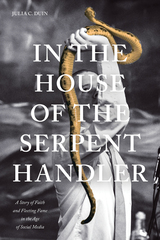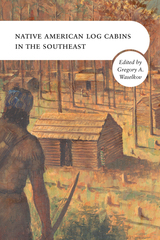
In the House of the Serpent Handler offers an intimate and engrossing look at the latest generation of Pentecostal believers who “take up” venomous snakes as a test of their religious faith. Focusing on several preachers and their families in six Appalachian states, journalist Julia C. Duin explores the impact that such twenty-first-century phenomena as social media and “reality television” have had on rituals long practiced in obscurity.
As Duin reveals, the mortal snakebite suffered by pastor Mack Wolford in 2012 marked the passing of the torch to younger preachers Jamie Coots and Andrew Hamblin, who were featured in the 2013 series Snake Salvation on the National Geographic Channel. Seeing their participation in the show as a way of publicizing their faith and thus winning converts, Coots and Hamblin attempted to reinvent the snake-handling tradition for a modern audience. The use of the internet, particularly Facebook, became another key part of their strategy to spread their particular brand of Christianity. However, Coots’s own death in 2014 was widely reported after the TV series was canceled, while Hamblin, who emerges as the central figure in the book, was arrested and tried after a shooting incident involving his estranged wife. His hopes of becoming a serpent-handling superstar seemingly dashed, Hamblin spent several months in prison, emerging more determined than ever to keep to the faith. By the end of the narrative, he has begun a new church where he can pass on the tradition to yet another generation.
Duin’s thorough, sympathetic reporting and lively style bring the ecstatic church services she witnessed vividly to life, and through interviews and quotations from the principals’ Facebook postings, she has allowed them to express their beliefs and reveal their everyday lives in their own words. She also gives the reader an up-close view of how a reporter pursues a story and the various difficulties encountered along the way. Together these elements frame a striking picture: the young practitioners of a century-old custom—one so often dismissed as bizarre by outsiders—adjusting to the challenges of the new millennium.
Julia C. Duin, the former religion editor for the Washington Times, has published articles in the Washington Post, the Wall Street Journal and other national publications. She is the author of five previous books, including, most recently, Days of Fire and Glory: The Rise and Fall of a Charismatic Community.


In a rapidly changing social, economic, and political landscape at the frontiers of an expansionist United States, the log cabin, a northern European house form, proved equally adaptable to the needs of settlers, slaves, and Native peoples. Each found ways to make log cabins their own. Beneath these deceptively simple hewn facades, indigenous principles of correctness guided southeastern Indians’ uses of interior cabin space, creations of raised clay hearths, and maintenance of pits that gave occupants access to the regenerative properties of the Beneath World. The chapters in this volume make important contributions toward a better understanding of houses and households in the Native Southeast by marshalling new data, methods, and theory to address an important but understudied phenomenon.

Seven Summers is the story of a naturalist-turned-professor who flees city life each summer with her pets and power tools to pursue her lifelong dream—building a cabin in the Wyoming woods. With little money and even less experience, she learns that creating a sanctuary on her mountain meadow requires ample doses of faith, patience, and luck. This mighty task also involves a gradual and sometimes painful acquisition of flexibility and humility in the midst of great determination and naive enthusiasm.
For Corbett, homesteading is not about wresting a living from the land, but respecting and immersing herself in it—observing owls and cranes, witnessing seasons and cycles, and learning the rhythms of wind and weather in her woods and meadow. The process changes her in unexpected ways, just as it did for women homesteaders more than a century ago. The more she works with wood, the more she understands the importance of “going with the grain” in wood as well as in life. She must learn to let go, to move through loss and grief, to trust her voice, and to balance independence and dependence. Corbett also gains a better understanding of her fellow Wyomingites, a mix of ranchers, builders, gas workers, and developers, who share a love of place but often hold decidedly different values. This beautifully written memoir will appeal to readers who appreciate stories of the western landscape, independent women, or the appreciation of the natural world.

READERS
Browse our collection.
PUBLISHERS
See BiblioVault's publisher services.
STUDENT SERVICES
Files for college accessibility offices.
UChicago Accessibility Resources
home | accessibility | search | about | contact us
BiblioVault ® 2001 - 2024
The University of Chicago Press









